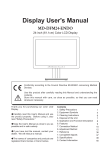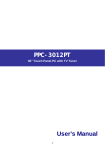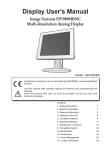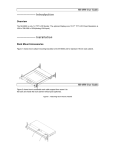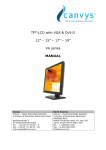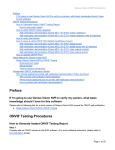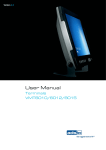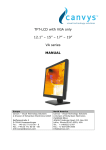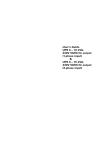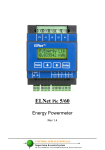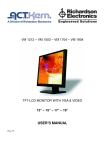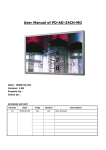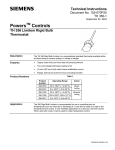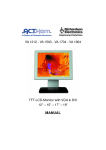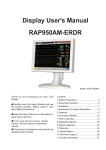Download Exit - Canvys
Transcript
User's Manual FP4200-OR 42-inch (107.1cm) Color LCD Display Conformity according to the Council Directive 93/42/EEC concerning Medical Devices. Use this product after carefully reading this Manual and understanding the contents. Store this manual in a safe place for future reference. ◆Carefully read this User's Manual and use the product properly. Before using it, also read "Safety Precautions." ◆If you have lost the manual, contact your dealer. We will reissue a manual. Contents 1. Safety Precautions 2. Equipment Symbols 3. Cleaning Instructions 4. Disposal of the Unit 5. Application and Function Description 6. Features 7. Connection Method 8. Adjustment Method 9. Reference 10. Compatible Signals 11. Specifications 12. Contact Information 1 4 6 7 8 9 10 12 32 33 35 37 Revision History The revision letter changes with related comments each time the document is updated. Revision Comment A Initial release of this document Power Management This Power Management System helps you to save energy by switching your monitor into a low-power consumption mode when it has not been used for a certain period of time. Power Management System operates with VESA DPMS compliant video card installed in your Workstation. Canvys highly recommends setting DPMS to activate after 15 minutes of non-usage in order to optimize your displays lifetime and to avoid Image retention damage. We also recommend users: Not to leave the same image or viewing frame too long in one position. Frequently changing and moving of image and viewing frame will help to avoid Image retention (also called “Image Sticky”). Image retention is a phenomenon inherent to TFT LCD displays technology itself, and as such, the occurrence of this “ghosting” effect is considered normal operation by the LCD glass manufacturer. As a result, Canvys is not responsible for this damage and does not warrant any displays against the occurrence of Image Sticking. We strongly advise that you follow the operating recommendations listed above. Power Management Modes State Normal operation Horizontal Sync Vertical Sync Video Power Indicator Active Active Active LED ON Power Consumption 250W Max DPMS Standby DPMS Suspend DPMS off Inactive Active Blanked Green Flashing (1sec interval) Less than 20W Active Inactive Blanked Green Flashing (1sec interval) Less than 20W Inactive Inactive Blanked Green Flashing (1sec interval) Less than 20W Safety Precautions I CAUTION Symbol Description Caution!-This symbol alerts you to important operating considerations or a potential operating condition that could damage equipment. Refer to user's manual or operation's manual for precautionary instructions. II CLASSIFICATION MEDICAL EQUIPMEN T WITH RESPECT TO ELECTRIC SHOCK, FIRE AND MECHANICAL HAZARD S ONLY IN ACCORDANCE WITH UL60601-1 AN D CAN/CSA C22.2 NO.601. 1 49CG Class I : No applied parts Protection against harmful ingress of water is IPX0. Not suitable for use in the presence of flammable anesthetic's or oxygen. Mode of operation: Continuous. III External Equipment External equipment intended for connection to signal input / output or other connectors, shall comply with UL/EN 60601-1 for medical electrical equipment. In addition, all such combination system shall comply with the standard IEC 60601-1-1, Safety requirements for medical electrical systems. Equipment not complying with UL/EN/IEC 60601-1 shall be kept outside the patient environment, as defined on the systems standard. IV Intended Use The equipment is intended to be used as a component of a medical patient monitoring system. 1 III FCC FCC Information FCC(U. S. Federal Communications Commission) This equipment has been tested and found to comply with the limits for a Class B digital device, pursuant to part 15 of the FCC Rules. These limits are designed to provide reasonable protection against harmful interference in a residential installation. This equipment generates, uses, and can radiate radio frequency energy, and if not installed and used in accordance with the instructions, may cause harmful interference to radio communications. However, there is no guarantee that interference will not occur in a particular installation. If this equipment does cause unacceptable interference to radio or television reception, which can be determined by turning the equipment off and on, the user is encouraged to try to correct the interference by one or more of the following measures: ● Reorient or relocate the receiving antenna. ● Increase the separation between the equipment and receiver. ● Connect the equipment into an outlet on a circuit different from that to which the receiver is connected. ● Consult your dealer or an experienced radio/TV technician for help. FCC Warning: To assure continued FCC compliance, the user must use a grounded power supply cord and the provided shielded video interface cable with bonded ferrite cores. Also, any unauthorized changes or modifications to this monitor would void the user's authority to operate this device. IV Precautions ● Make sure to carefully read the Operating Manual prior to using the monitor in order to properly use the monitor. ● Note that, excluding those cases where a responsibility for legal compensation is recognized, the manufacturer shall bear absolutely no responsibility for damage to this product by a customer or a third party that results from the ignoring of contents entered in this Operating Manual and mistaken use. ● Follow the instructions below for safety use of the LCD Monitor. - To avoid electric shock, do not attempt to remove any cover or touch the inside of the monitor. Only a qualified service technician should open the monitor case. - Do not insert metal objects or spill liquid into the LCD monitor through cabinet slots. They may cause accident fire, electric shock or failure. If a foreign object inserted or water penetrated, unplug the AC cable and have the monitor serviced. - Do not cover or block the vent holes in the case. - Disconnect the power plug from the AC outlet if you will not use it for an indefinite period of time. - Do not touch the screen directly with your fingers. You may damage the screen, and oil from your skin is difficult to move. - Do not apply pressure to the screen. The LCD is very delicate. 2 ● If your LCD monitor does not operate normally, if there are any unusual sounds or smells coming from it Disconnect AC power cord from monitor immediately and contact Canvys for service. V Environment - 3 Place the monitor on a flat and leveled surface. Place the monitor in a well-ventilated place. Keep sunlight away from monitor. Keep monitor away from: Overly hot, cold, humid and dusty places. Keep monitor away from strong magnetic fields. Equipment Symbols Electrical and Electronic Equipment Symbols In addition to the equipment symbols described in your user's manual, the following symbols may be appear on the monitor. Alternating current. Direct current. European Union Declaration of Conformity. FCC. USA only. Complies with applicable US government (Federal Communications Commission) radio-frequency interference regulations. Fragile. Handle with care. Indicates front. Keep dry. Protect from rain. Mercury. This product consists of devices that may contain mercury, which must be recycled or disposed of in accordance with local, state, or country laws. ON. Power connection to the mains. Recycled materials or may be recycled. Stacking limit by number. Standby or power indicator. This way up. USB connector port. 4 This symbol indicates that the waste of electrical and electronic equipment must not be disposed as unsorted municipal waste and must be collected separately. Please contact an authorized representative of the manufacturer for information concerning the decommissioning of your equipment ATTENTION: Consult accompanying documents. DANGER - Shock Hazard. Dangerous voltage. To reduce the risk of electric shock, do not remove cover. Refer servicing to qualified service personnel. 5 Cleaning Instructions Cleaning Instructions Using a spray applicator, apply any of the approved liquids from the list below and use a soft lint free cloth to clean the screen. 1. Water 2. Windex Blue (glass surfaces only) 3. Mild Soap Notice: This monitor has been adjusted specifically for use in the region to which it was originally shipped. If the product is used outside the region, it may not operate in the specifications. Please wait 20-40 minutes after powering on the monitor before adjusting, as it takes roughly this same amount of time for the optimum performance of the electrical parts. The screen may have defective pixels. These pixels may appear as slightly light or dark area on the screen. This is due to the characteristics of the panel itself, and not the monitor. The backlight of the LCD panel has a fixed life span. When the screen becomes dark or begins to flicker, please contact your dealer. Do not press on the panel or edge of the frame strongly, as this may result in the display malfunction, such as the interference patterns, etc. If pressure is continually applied to the LCD panel, it may deteriorate or damage your LCD panel. Do not scratch or press on the panel with any sharp objects, such as a pencil or pen as this may result in damage on the panel. Do not attempt to brush with tissues as this may scratch the LCD panel. When you bring the monitor from cold temperature room into a high temperature room or when your room temperature goes up quickly from low to high, dew condensation may occur inside and outside the monitor. In this case, do not turn on the monitor. Please wait till dew condensation disappears. Otherwise it may cause some damages to the monitor. Prolonged operation of an LCD with the same content on the same screen area may result in a form of image retention. You can avoid or significantly reduce the occurrence of this phenomenon by using a screen saver. You can activate a screen saver in the “Display Properties” window of your workstation. Canvys recommends setting screen saver activation after 5 minutes of non-usage. In case you are working with the same image or an application with static image elements for several hours continuously (so that the screensaver is not activated); change the image content regularly to avoid image retention of the static elements. Image retention is a phenomenon inherent to TFT LCD displays technology itself, and as such, the occurrence of this “ghosting” effect is considered normal operation by the LCD glass manufacturer. As a result, Canvys is not responsible for this damage and does not warrant any displays against the occurrence of Image Sticking. We strongly advise that you follow the operating recommendations listed above. 6 Disposal of the Unit ●Do not dispose of this product with general wastes. ●Follow your local regulations or rules upon dispose of this product. ●Hg WARNING This product consists of devices that may contain mercury, which must be recycled or disposed of in accordance with local, state, or country laws. (Within this product, the backlight lamps in the display contain mercury.) 7 Application and Function Description ●Some Basic Facts The liquid-crystal display (LCD) monitor supports the most common resolutions from 640 x 480 (VGA) up to 1920 x 1080 and presents sharp, low-radiation images. With the OSD touch key on the bottom right side of the display leaves ample space on your desk for other peripheral equipment. ●Function Descripion The medical flat-screen display is built into a slim and ergonomic housing. The monitor displays 16.7 million colors with a resolution of 1920 x 1080 pixels. The signal is equivalent to the analog and digital standard signals of your PC. After connection of the signal the flat-screen display automatically adapts, as far as possible, to the VGA signal and presents a stable and centered image. Additional display parameters, such as brightness and contrast, can be adjusted via the on-screen menu. The equipment supplied includes the signal cables, the power supply with power cord and this user manual. 8 Features ●42-inch LCD display with 2 million pixels This color LCD display has a multi-scanning function corresponding to the resolution from VGA 640 x 400 to WUXGA 1920 x 1080. This is also compliant with VESA standard display mode. ●High-intensity, high-contrast Beautiful and clear images of the brightness of 700 cd/m2 and contrast ratio of 3500:1 have been achieved. Viewing angles are the wide range of 178 degrees in both horizontal and vertical directions (CR>=10). The unit has installed our unique automatic brightness stabilizing circuit that restrains deteriorations and brightness drifts when power is turned on. Gamma curve adjustments are made by OSD. This is for various modality terminals, medical image displays for PACS*1, and graphics. ●Remote control port This color LCD display has the remote control port that controls the functions of the monitor. ●Power management This unit has loaded the power management system. The power management mode functions when either horizontal or vertical signals or both disappears, and it reduces power consumption to less than 20W. ●VESA® standard wall / arm mountings The unit is compliant with VESA's hanging tools. The tilt stand is detachable; the unit can be set for wall-hanging or arm according to users' environment. Note 1) PACS: Picture Archive & Communication System 9 Connection Method 1. Confirm that your computer is off. Then, confirm that the main switch of the color LCD monitor on the back is off. Caution AC Main Power supply Switch The AC main power supply switch interrupts the AC input to the display. Placing the switch in the ON (I) position allows display to power-up, if the AC input is connected. Placing the switch in the OFF (O) position shall cause the display to power down. 2. Connect the signal cable (for PC input) Connect the VGA connector of the monitor and the analog RGB output connector with the attached VGA cable. Connect the DVI connector of the monitor and the digital RGB output connector with the attached DVI cable (24-pin DVI). 10 3. Connect Video signal Cable (for video device output) Connect S-Video connector of the LCD monitor and an S-Video output device with the attached S-Video cable. For composite signal connect the BNC connector of the monitor and a composite video output device with the composite video cable. 4. Connect component Video connector of the LCD monitor and a component Video output device with the component video cable. Connect HDMI connector of the LCD monitor and a HDMI output device with the HDMI cable. 11 Adjustment Method Names and Functions of Each Part ① Touch key Power ON/OFF ・Pressing “Power” key turns on the LCD display. ・Pressing “Power” key for more than three seconds turns the power off. OSD control ・When “Menu” key is pressed while images are on screen, OSD* will appear on screen. *OSD stands for on-screen-display. Its function is to display information such as characters and symbols. ・Execution of selected items and display of submenus can be performed while OSD is on screen. Press “Enter” key: execute/ select items/ save data Source select ・Pressing “Source” key (VGA,DVI,HDMI...) changes the present source. ② POWER indicator (Power/ Power management display) ・The indicator illuminates green when power normally on. ・The indicator illuminates orange when power management function on or no signals. ・The indicator goes out when power off. ③ IR Receiver: Receives IR signals from the remote control. ④ Main power supply switch: Main switch of the LCD display. 12 ⑤ AC inlet: Connect the attach AC cord to the inlet (See accessory box for cable). ⑥ CVBS Video input/output connector: Composite signal input. (See accessory box for cable). ⑦ Component/RGBS input/output connector: When using component input to watch a DVD, HD (High Definition) or RGBS video image. The component video connector cable is connected to this and a component output video device. (See accessory box for cable). ⑧ S-Video input/output connector: S-Video signal input. (See accessory box for cable). ⑨ Analog input connector VGA: Analog video signal input. The analog signal cable is plugged into this. ⑩ Digital input connector DVI: Digital video signal input. (See accessory box for cable). ⑪ Digital input connector HDMI: Digital video signal input. The provided digital signal cable is plugged into this. (See accessory box for cable). ⑫ Control input connector GPIO DIN-9 ⑬ Calibration connector USB: Connect with PC to calibrate Gamma curve. 13 Mounting The Monitor can be mounted onto the wall or stand. If you intend to mount the monitor on the wall, we strongly recommend that you use wall mount kits with attached M8*12mm screws and can load more than monitor weight, that you ensure it is securely and safely installed. CAUTION: When mounting the monitor, take care to tighten the retention screws or bolts until fully secure, but do not over tighten. Over tightening the retention screws or bolts may cause them to become stripped, rendering them useless. Wall Mounting Installation The Monitor has Video Electronics Standards Association (VESA) standard mounting holes tapped into the rear panel. The standard holes are M8 set at 400 mm x 200 mm or 200mm x 200mm apart. To mount the Monitor onto the wall or stand, please follow the steps below. Step 1: Select the location on the wall for the wall-mounting bracket.(Listed VESA) Step 2: Carefully mark the locations of the four screw holes in the bracket on the wall Step 3: Drill four pilot holes at the marked locations on the wall for the bracket retention screws. Step 4: Align the wall-mounting bracket screw holes with the pilot holes. Step 5: Secure the mounting-bracket to the wall by inserting the retention screws into the four pilot holes and tightening them. Step 6: Insert the four monitor mounting screws provided in the wall mounting kit into the four screw holes on the real panel of the LCD Monitor and tighten until the screw shank is secured against the rear panel. Step 7: Align the mounting screws on the monitor rear panel with the mounting holes on the bracket. Step 8: Carefully insert the screws through the holes and gently pull the monitor downwards until the monitor rests securely in the slotted holes. Ensure that all four of the mounting screws fit snuggly into their respective slotted holes. Step 9: Secure the LCD Monitor by fastening the retention screw of the wall-mounting bracket. Step 10: Secure the LCD Monitor by fastening the retention screw of the wall-mounting bracket. 14 Charts of OSD Adjustment Functions The charts displays the function tree and brief explanations of the functions.Color,LCD,and other adjustments have submenus under each tree. ● OSD display Main menu display • Exit• • • • • • • • • • • • • • • • • • • • • • • • • • • • • • • • • • • • • • • • • • • • • • • • • • • • • Close the OSD screen • Input Source Settings Exit• • • • • • • • • • • • • • • • • • • • • • • • • • • • • • • • • • • • • • • • • • Return to Main Menu Analog VGA• • • • • • • • • • • • • • • • • • • • • • • • • • • • • Select Analog video input for Main channel Digital• • • • • • • • • • • • • • • • • • • • • • • • • • • • • • • • • • • • • • • Select DVI digital video input for Main channel HDMI• • • • • • • • • • • • • • • • • • • • • • • • • • • • • • • • • • • • • • • Select HDMI digital video input for Main channel S-Video• • • • • • • • • • • • • • • • • • • • • • • • • • • • • • • • • • • • Select S-video video input for Main channel CVBS• • • • • • • • • • • • • • • • • • • • • • • • • • • • • • • • • • • • • • • Select Composite video input for Main channel YPbPr/YCbCr• • • • • • • • • • • • • • • • • • • • • • • • • • Select Component video input for Main channel RGBS• • • • • • • • • • • • • • • • • • • • • • • • • • • • • • • • • • • • • • Select R, G, B, Xs-sync video input for Main channel • Image Settings Exit• • • • • • • • • • • • • • • • • • • • • • • • • • • • • • • • • • • • • • • • • • • Return to Main Menu Auto Setup• • • • • • • • • • • • • • • • • • • • • • • • • • • • • • • Automatic screen size/position adjustment Brightness• • • • • • • • • • • • • • • • • • • • • • • • • • • • • • Adjust the backlight of the full screen by the range from 0 to 100 Black Level• • • • • • • • • • • • • • • • • • • • • • • • • • • • • Adjust the black level offset for the Main channel by the range from 0 to 100 Contrast• • • • • • • • • • • • • • • • • • • • • • • • • • • • • • • • • • • Adjust the contrast for the Main channel by the range from 0 to 100 Saturation• • • • • • • • • • • • • • • • • • • • • • • • • • • • • • • • Adjust the saturation for the Main channel by the range from 0 to 100 Hue• • • • • • • • • • • • • • • • • • • • • • • • • • • • • • • • • • • • • • • • • • Adjust the hue for the Main channel by the range from 0 to 100 Sharpness• • • • • • • • • • • • • • • • • • • • • • • • • • • • • • • Adjust the sharpness for the Main channel by the range from 0 to 24 Display Exit• • • • • • • • • • • • • • • • • • • • • • • • • • • • • Return to Exit of Image Setting page H.Position• • • • • • • • • • • • • • • • • • • Adjust horizontal screen position for Main channel V.Position• • • • • • • • • • • • • • • • • • • Adjust vertical screen position for Main channel Clock• • • • • • • • • • • • • • • • • • • • • • • • • • Adjust the clock for the video signals for Main channel Phase• • • • • • • • • • • • • • • • • • • • • • • • • Adjust the phase for the video signals for Main channel Video Setup• • • • • • • • • • • • • • • • • • • • • • • • • • • • • * Notice: Only support for S-video & CVBS & YPbPr/PCbCr & RGBS Exit• • • • • • • • • • • • • • • • • • • • • • • • • • • • • • • • • • • • • • Return to Exit of Image Setting page Main MADI Mode• • • • • • • • • • • • • • • Motion adaptive De-interlacing that support Off & Normal & Adaptive three modes Noise Reduction Exit• • • • • • • • • • • • • • • • • • • • • • • • • • • • • Return to Exit of Video Setup of Image Setting page Dynamic NR mode• • • • • Dynamic NR mode that support Off & High & Medium & Low & Adaptive five Modes • • • • • • • • • MPEG NR mode MPEG NR mode that support On & Off two modes Sharpness Noise coring Off, adaptive Low, Medium, High Film Mode• • • • • • • • • • • • • • • • • • • • • • • • • • • Film Mode that support 3:2 & 3:2-2:2 & Off & 2:2 four modes DCDi• • • • • • • • • • • • • • • • • • • • • • • • • • • • • • • • • • • DCDi support Off & On two modes 15 • Color Mode Settings Exit• • • • • • • • • • • • • • • • • • • • • • • • • • • • • • • • • • • • • • • • • • Return to Main Menu Color Temp. Exit• • • • • • • • • • • • • • • • • • • • • • • • • • • • • Return to Exit of Color Mode Settings page Cool• • • • • • • • • • • • • • • • • • • • • • • • • • • • Bluish white used for general use Neutral• • • • • • • • • • • • • • • • • • • • • • • • White close to natural light mainly used for publishing trade Warm• • • • • • • • • • • • • • • • • • • • • • • • • • Reddish white suitable mainly for photo modifications User Exit• • • • • • • • • • • • • • • • Return to Exit of Color Temp. of Color Mode Settings page Red Gain• • • • • • • User adjusts the gain of Red by the range from 0 to 100 Green Gain• • • User adjusts the gain of Green by the range from 0 to 100 Blue Gain• • • • • • User adjusts the gain of Blue by the range from 0 to 100 Gamma Exit• • • • • • • • • • • • • • • • • • • • • • • • • • • • • Return to Exit of Color Mode Settings page Gamma 1.8• • • • • • • • • • • • • • • • Set Gamma curve to curve 1.8 Gamma 2.0• • • • • • • • • • • • • • • • Set Gamma curve to curve 2.0 Gamma 2.2• • • • • • • • • • • • • • • • Set Gamma curve to curve 2.2 Gamma 2.4• • • • • • • • • • • • • • • • Set Gamma curve to curve 2.4 Monochorme• • • • • • • • • • • • • • Set full screen without color Calibration• • • • • • • • • • • • • • • • • • Calibrate monitor setting by using external device DICOM• • • • • • • • • • • • • • • • • • • • • • • Set Gamma curve to DICOM curve • Multi-PIP Settings Exit• • • • • • • • • • • • • • • • • • • • • • • • • • • • • • • • • • • • • • • • • • PIP mode• • • • • • • • • • • • • • • • • • • • • • • • • • • • • • • • PIP Source Exit• • • • • • • • • • • • • • • • • • • • • • • • • • • • • Analog VGA• • • • • • • • • • • • • • • Digital• • • • • • • • • • • • • • • • • • • • • • • • • HDMI• • • • • • • • • • • • • • • • • • • • • • • • • • S-Video• • • • • • • • • • • • • • • • • • • • • • CVBS• • • • • • • • • • • • • • • • • • • • • • • • • YPbPr/YCbCr• • • • • • • • • • • • • RGBS• • • • • • • • • • • • • • • • • • • • • • • • • PIP Display Exit• • • • • • • • • • • • • • • • • • • • • • • • • • • • • PIP Size Exit• • • • • • • • • • • • • • • • • • • • • PIP Size• • • • • • • • • • • • • • PIP H-Size• • • • • • • • • • PIP V-Size• • • • • • • • • • PIP Position Exit• • • • • • • • • • • • • • • • • • • • • PIP H. Position• • • PIP V. Position• • • • Swap• • • • • • • • • • • • • • • • • • • • • • • • • • • • • • • • • • • • • • • Return to Main Menu Select PIP mode to Off or PIP or POP Return to Exit of Multi-PIP Settings page Select Analog video input for Sub channel Select DVI digital video input for Sub channel Select HDMI digital video input for Sub channel Select S-video video input for Sub channel Select Composite video input for Sub channel Select Component video input for Sub channel Select R, G, B, Xs-sync video input for Sub channel Return to Exit of Multi-PIP Settings page Return to Exit of PIP Display of Multi-PIP Settings page Adjust the full size for Sub channel display Adjust the H size for Sub channel display Adjust the V size for Sub channel display Return to Exit of PIP Display of Multi-PIP Settings page Adjust the H position for Sub channel display by the range from 0 to 100 Adjust the V position for Sub channel display by the range from 0 to 100 Swap source between Main and Sub channel 16 PIP Picture Exit• • • • • • • • • • • • • • • • • • • • • • • • • • • • • Black Level• • • • • • • • • • • • • • • • • Contrast• • • • • • • • • • • • • • • • • • • • • • Saturation• • • • • • • • • • • • • • • • • • • Hue• • • • • • • • • • • • • • • • • • • • • • • • • • • • • Sharpness• • • • • • • • • • • • • • • • • • • OSD Misc. Exit• • • • • • • • • • • • • • • • • • • • • • • • • • • • • • • • • • • • • • • • • • • OSD Position Exit• • • • • • • • • • • • • • • • • • • • • • • • • • • • • OSD H.Position• • • • • • • • • • OSD V.Position• • • • • • • • • • • Language Exit• • • • • • • • • • • • • • • • • • • • • • • • • • • • • English• • • • • • • • • • • • • • • • • • • • • • • • Francais• • • • • • • • • • • • • • • • • • • • • • Deutsch• • • • • • • • • • • • • • • • • • • • • • Italiano• • • • • • • • • • • • • • • • • • • • • • • • Espanol• • • • • • • • • • • • • • • • • • • • • • 日本語• • • • • • • • • • • • • • • • • • • • • • • • • 簡體中文• • • • • • • • • • • • • • • • • • • • • OSD Timer• • • • • • • • • • • • • • • • • • • • • • • • • • • • • • • Transparent• • • • • • • • • • • • • • • • • • • • • • • • • • • • • • Management Settings Exit• • • • • • • • • • • • • • • • • • • • • • • • • • • • • • • • • • • • • • • • • • • Scaling Exit• • • • • • • • • • • • • • • • • • • • • • • • • • • • • Scaling• • • • • • • • • • • • • • • • • • • • • • • • Zoom• • • • • • • • • • • • • • • • • • • • • • • • • • Her. Zoom• • • • • • • • • • • • • • • • • • • Ver. Zoom• • • • • • • • • • • • • • • • • • • Auto Setup ON/OFF• • • • • • • • • • • • • • • • ALS ON/OFF• • • • • • • • • • • • • • • • • • • • • • • • • • • Auto Source SW• • • • • • • • • • • • • • • • • • • • • • KeypadDrive Exit• • • • • • • • • • • • • • • • • • • • • • • • • • • • • Brightness• • • • • • • • • • • • • • • • • • Sensitivy• • • • • • • • • • • • • • • • • • • • • • • • Recall • • • • • • • • • • • • • • • • • • • • • • • • • • • • • • • • • • • • 17 Return to Exit of Multi-PIP Settings page Adjust the black level offset for the Sub channel by the range from 0 to 100 Adjust the contrast for the Sub channel by the range from 0 to 100 Adjust the saturation for the Sub channel by the range from 0 to 100 Adjust the hue for the Sub channel by the range from 0 to 100 Adjust the sharpness for the Sub channel by the range from 0 to 24 Return to Main Menu Return to Exit of OSD Misc. Adjust the H position for OSD by the range from 0 to 100 Adjust the V position for OSD by the range from 0 to 100 Return to Exit of OSD Misc Display OSD in English Display OSD in French Display OSD in German Display OSD in Italian Display OSD in Spanish Display OSD in Japanese Display OSD in Simplified Chinese Adjust OSD display time Adjust OSD display transparent Return to Main Menu Return to Exit of Management Settings page Support Full & 1:1 & 4:3 & 16:9 & 16:10 Screen 5 modes Adjust the full size for Main channel display(Must under Full scaling mode) Adjust the H size for Main channel display (Must under Full scaling mode) Adjust the V size for Main channel display (Must under Full scaling mode) On/off ‘’Auto Adjustment’’ Function On/off ‘’Auto Luminance System ’’ Function Automatically select the signal source Return to Exit of Management Settings page Control the touch key backlight 4~22 Control the touch key sensitivy 0~100 Initialize to the factory settings and delete the specify User setting you saved Photos Describe the OSD Adjustment Functions The below photos will detail introduce every menu of OSD tree and brief explanations of the functions. Detail of Adjustment Items Exit Close the Main Menu. In addition, this page will show below messages: (1)Information for input timing of Main channel . (2)Indicate which source display for Main channel. (3)Indicate which source display for Sub channel. (4)Record how long time display for this monitor already. Input Source Setting You can select source for Main channel from Analog VGA, Digital, HDMI, S-video, CVBS, YPbPr/ PCbCr, RGBS. 18 Image Settings Adjust values of below items for Main channel. Beside VideoSetup that only support on S-video & CVBS & YPbPr/PCbCr & RGBS. * Notice: VideoSetup will be disable under Analog VGA or Digital source. Exit Return to Main Menu. Auto Setup When you press ‘’Auto Setup’’ will show ‘’Auto Adjusting’’ on the screen that do automatically adjust the size, position, brightness, contrast and the like of the screen. When first using this color display or input new timing will perform this adjustment. When ‘’Auto Adjusting’’ disappear from the screen means it have finished the ‘’Auto Setup’’ function. Black Level Adjust the black level offset for the Main channel by the range from 0 to 100. Black Level 50 Contrast Adjust the contrast for the Main channel by the range from 0 to 100. 19 Saturation Adjust the saturation for the Main channel by the range from 0 to 100. Hue Adjust the hue for the Main channel by the range from 0 to 100. Sharpness Adjust the sharpness for the Main channel by the range from 0 to 24. Sharpness 12 Display Adjust the Horizontal & Vertical position & clock & phase for Main channel. • Exit Return to Exit of Image Setting page. • H.Position Adjust horizontal screen position for Main channel by the range from 0 to 100. • V.Position Adjust vertical screen position for Main channel by the range from 0 to 100. 20 • Clock Adjust the frequency sampling rate of horizontal pixels for Main channel, to equal the video source’s value,Thus minimizing artifacts of shimmering vertical lines. * Notice: Only support on Analog VGA source. • Phase Adjust ADC sampling clock phase for Main channel, so that the screen image appear crisp and focused. * Notice: Only support on Analog VGA source. Color Mode Settings Selecting this control allows you select color temperature or gamma curve. Exit Return to Main Menu. Color Temp. Selecting this control allows you to select preset color temperature of Cool, Neutral, Warm, or User for customized red, green and blue levels. 21 • Exit Return to Exit of Color Mode Settings page. • Cool Bluish white used for general use. • Neurtal White close to natural light mainly used for publishing trade. • Warm Reddish white suitable mainly for photo modifications. • User Selecting this control allows you to adjust the Red gain, Green gain and Blue gain individually to match personal preference. Exit Return to Exit of Color Mode Settings page. Red Gain You can adjusts the gain of Red by the range from 0 to 100. Green Gain You can adjusts the gain of Green by the range from 0 to 100. Blue Gain You can adjusts the gain of Blue by the range from 0 to 100. 22 Gamma Selecting this control allows you to choose which gamma curve that you want. • Exit Return to Exit of Color Mode Settings page. • Gamma 1.8 Set Gamma curve to curve 1.8 • Gamma 2.0 Set Gamma curve to curve 2.0 • Gamma 2.2 Set Gamma curve to curve 2.2 • Gamma 2.4 Set Gamma curve to curve 2.4 • Monochrome Set full screen without color. • Calibration Set Gamma curve to calibration mode. • DICOM Set Gamma curve for medical standards. 23 Multi-PIP Settings Selecting this control allows you to adjust below items settings for Sub channel. * Notice: PIP Display & Swap & PIP Picture only active when PIP Mode set to PIP or POP. Exit Return to Main Menu. PIP mode Select PIP mode to Off mode or PIP mode or POP mode as below: PIP source You can select source for Sub channel from Analog VGA, Digital, HDMI, S-video, CVBS, YPbPr/ PCbCr, RGBS (Gray area are not available to choose). Please find the below matrix to see the combinations for Main channel with Sub channel if you set to PIP mode or POP mode. Main channel VGA DVI HDMI S-video CVBS YPbPr RGBS VGA X O O O O O O DVI O X X O O O O Sub channel HDMI S-video CVBS O O O X O O X O O O X O O O X O O O O O O YPbPr O O O O O X X RGBS O O O O O X X 24 PIP Display Selecting this control allows you to adjust the size and position for Sub channel. • Exit Return to Exit of Multi-PIP Settings page. • PIP Size Selecting this control allows you to adjust the size for Sub channel. Exit Return to Exit of PIP Display of Multi-PIP Settings page. PIP Size Adjust the full size for Sub channel display. PIP H Size Adjust the H size for Sub channel display. PIP V Size Adjust the V size for Sub channel display. 25 • PIP Position Selecting this control allows you to adjust the position for Sub channel. Exit Return to Exit of PIP Display of Multi-PIP Settings page. PIP H.Position Adjust the H position for Sub channel display by the range from 0 to 100. PIP V.Position Adjust the V position for Sub channel display by the range from 0 to 100. Swap Swap source between Main and Sub channel. PIP Picture Selecting this control allows you to adjust the below items settings for Sub channel. • Exit Return to Exit of Multi-PIP Settings page. • Black Level Adjust the black level offset for the Sub channel by the range from 0 to 100. • Contrast Adjust the contrast for the Sub channel by the range from 0 to 100. 26 • Saturation Adjust the saturation for the Sub channel by the range from 0 to 100. • Hue Adjust the hue for the Sub channel by the range from 0 to 100. • Sharpness Adjust the sharpness for the Sub channel by the range from 0 to 24. * Notice: Only Sub channel support are S-video or CVBS or YPbPr/ PCbCr & or RGBS. OSD Misc. Selecting this control allows you to adjust below items settings for OSD. Exit Return to Main Menu. OSD Position Selecting this control allows you to adjust position for OSD. 27 • Exit Return to Exit of OSD Misc. • OSD H.Position Adjust the H position for OSD by the range from 0 to 100. • OSD V.Position Adjust the V position for OSD by the range from 0 to 100. Language Selecting this control allows you to choose below languages that you want to display for OSD. • Exit Return to Exit of OSD Misc. • English Display OSD in English. • Francais Display OSD in French. • Deutsch Display OSD in German. • Italiano Display OSD in Italian. • Espanol Display OSD in Spanish. • 日本語 Display OSD in Japanese. • 簡體中文 Display OSD in Simplified Chinese. 28 OSD Timer Adjust OSD display time that support 0 & 5 & 10 & 15 & 20 & 25 & 30 OSD will not disappear if set to 0 OSD will disappear after 5 sec if set to 5 (just like that for 10 & 15 & 20 & 25 & 30) Transparent Adjust OSD display transparent from 0 to 7 by one step. 29 Management Settings Selecting this control allows you to adjust below items settings for Main channel. Exit Return to Main Menu. Scaling Selecting this control allows you to adjust below items relate to image scaling for Main channel. • Exit Return to Exit of Management Settings page. • Scaling Support Full & 1:1 & 4:3 & 16:9 & 16:10 5 modes. • Zoom Adjust the full size for Main channel display. * Notice: To Support Zoom Mode, must be under full scaling mode for each source. • Her. Zoom Adjust the H size for Main channel display. * Notice: To Support Horiz. Zoom, must be under Full scaling mode for each source. 30 • Ver. Zoom Adjust the V size for Main channel display. * Notice: To Support Ver. Zoom, must be under Full scaling mode for each source. • Auto Setup ON/OFF Select this function to on or off ‘’Auto Setup’’ Function. • Auto Source SW Select this function to on or off ‘’Auto Source’’ Function. KeypadDrive Control touch key pad. • Exit Return to Exit of Management Settings page. • Brightness Control the touch key backlight 4~22. • Sensitivy Control the touch key sensitivy 0~100. Recall Select this function to recall all OSD adjustments to the factory default settings and delete the specify User setting you used. 31 Reference DDC*1 ◆ This unit has loaded a function compliant with DDC-2B, VESA* standard. The DDC function is located in 15-pin D-sub connector and 24-pin DVI-D connector. This function reads into the set data written in the color LCD display internal device in advance on start-up of Windows®95/98/Me/2K/XP or Windows®7 and sets the detailed information of the color LCD display in the system file in order to achieve Plug & Play. Data reading from the color LCD display is done through a video signal cable, which needs to be connected when Windows®95/98/Me/2K/XP or Windows®7 is on. Note *1DDC (Display Data channel) and*2 VESA are registered trademarks of Video Electronics Standards Association. Power Management This Power Management System helps you to save energy by switching your monitor into a low-power consumption mode when it has not been used for a certain period of time. Power Management System operates with VESA DPMS compliant video card installed in your Workstation. Canvys highly recommends setting DPMS to activate after 15 minutes of non-usage in order to optimize your displays lifetime and to avoid Image retention damage. We also recommend users: Not to leave the same image or viewing frame too long in one position. Frequently changing and moving of image and viewing frame will help to avoid Image retention (also called “Image Sticky”). Image retention is a phenomenon inherent to TFT LCD displays technology itself, and as such, the occurrence of this “ghosting” effect is considered normal operation by the LCD glass manufacturer. As a result, Canvys is not responsible for this damage and does not warrant any displays against the occurrence of Image Sticking. We strongly advise that you follow the operating recommendations listed above. Power Management Modes State Normal operation Horizontal Sync Vertical Sync Video Power Indicator Active Active Active LED ON Power Consumption 250W Max DPMS Standby DPMS Suspend DPMS off Inactive Active Blanked Green Flashing (1sec interval) Less than 20W Active Inactive Blanked Green Flashing (1sec interval) Less than 20W Inactive Inactive Blanked Green Flashing (1sec interval) Less than 20W 32 Compatible Signals Applicable Signals Timings ※The display may not work correctly with timings other than listed below. Resolution 640 x 350 640 x 400 640 x 480 720 x 350 800 x 600 1024 x 768 1152 x 864 1280 x 960 1360 x 768 1280 x 1024 1680 x 1050 1600 x 1200 1920 x 1080 1280 x 720 33 VGA & DVI H-Freq(KHz) V-Freq(Hz) 31.47 70 37.86 85.08 31.47 70.07 37.86 85.08 31.47 50.02 31.47 59.93 37.86 72.81 37.5 75 43.27 85.01 35 66.67 31.47 70.08 37.96 85.04 35.16 57.16 37.88 60.02 48.83 66.89 48.08 72.19 46.88 75 53.67 85.06 35.52 43.48 47.74 59.94 56.48 70 57.7 72 60.02 75.03 68.68 85 67.5 75 60 60 75 75 47.71 60.015 63.98 60.02 79.98 75.02 64.674 59.883 75 59.94 55.6 50 66.7 59.99 36.994 49.925 44.38 60,00 Timing mode name VGA 350-70 VGA 350-85 VGA 400-70 VGA 400-85 VGA 480-50 VGA 480-60 VESA 480-72 VESA 480-75 VESA 480-85 MAC 480-66 VGA-TEXT 350-70 XGA II 350-85 SVGA-56 VESA 600-60 MAC 600-66 SVGA -72 VESA 600-75 VESA 600-85 IBM-8514A i VESA768-60 XGA-70 XGA-72 VESA 768-75 VESA 768-85 MAC 864-75 VESA 960-60 VESA 960-75 VESA 1360x768-60 VESA 1024-60 VESA 1024-75 VESA 1680x1050-60 UXGA 1200-60 1080P50 1080P60 720P50 720P60 S-Video Resolution NTSC PAL Composite Resolution NTSC PAL YPbPr Resolution 1080i 720P NTSC PAL 1080P50 1080P60 RGBS Resolution RGBS_VGA60 RGBS_SVGA60 RGBS_XGA60 RGBS_SXGA60 RGBS_NTSC RGBS_PAL HDMI Resolution 1080P 1080i 720P NTSC 34 Specifications Product name :42"Color LCD Display Specifications Items LCD display device 107.1cm (42 inch)Color TFT Normally Black Pixel pitch Horizontal 0.4845mm x Vertical 0.4845mm Display area Horizontal 930.24mm x Vertical 523.26mm Pixel 1920 x 1080 pixels Display gradation 16.77 billion (8 bit each) x3 Response Time 8 ms (Typ.) (Gray to Gray) Contrast Ratio 3500 : 1 (Typ.) Brightness 700 cd/m2 (Typ.) ; 550 cd/m2 (Min.) Standard viewing angle Horizontal : 178 deg. Input signal (1) VGA (15-pin D-SUB) Video signal: Analog RGB(0.714Vp-p/75Ω) Horizontal sync and composite sync signal: TTL level 2.5~5.5V (2) HDMI (19-pin HDMI) connector (3) DVI (24-pin DVI) connector compliant with DVI 1.0 (4) S-Video connector Color signal: 1Vp-p/75 Ω Brightness signal: 1Vp-p/75 Ω (composite sync signal) (5) BNC connector: Composite signal: 1Vp-p/75 Ω (6) BNC connector: Compnent signal: Y(0.714Vp-p/75 Ω), Pb/Cb, Pr/Cr (0.35Vp-p/75 Ω) RGBS signal: R.G.B (0.714Vp-p/75 Ω) S: Sync (2-5Vp-p) Temperature 35 Vertical : 178 deg. Operating Temperature : 10~40°C Humidity(non-condensation) : 30~75% Air pressure : 700~1060hPa Storage and Transport -20~60°C 10~90% 500~1060hPa Power Supply 100-240V~, 50/60Hz, 4-2A Power Consumption Approx.250W Max. External dimensions Width 1020.2mm x Height 613.2mm x Depth 120mm Mass Approx. 30 kg International standards UL60601-1, CSA C22.2 NO.601.1, FCC, ICES, CE(IEC/EN60601-1, EN60601-1-2), CISPR Less than 20W when power management on. External Dimensions 36 Contact Information Contact Information: Canvys - Visual Technology Solutions A Division of Richardson Electronics Raiffeisenstr. 5 78166 Donaueschingen Germany Tel: +49-771-83000 Fax: +49-771-830080 [email protected] www.canvys.de Copyright Notice This document is copyrighted. All rights are reserved. Neither this document, nor any part of it, may be reproduced or copied in any form or by any means-graphical, electronic, or mechanical including photocopying, taping or information storage and retrieval systems without written permission of Canvys a division of Richardson Electronics © 2010 Canvys a division of Richardson Electronics. All rights reserved. Model : FP4200-OR 37 MDLL9PR010









































